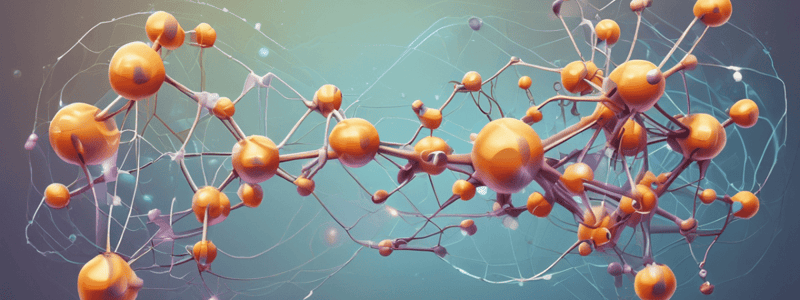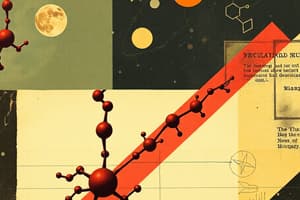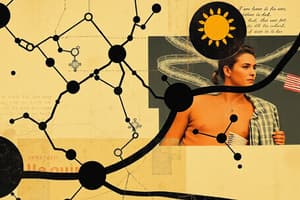Podcast
Questions and Answers
What is the numbering convention for elements in pyrimidines?
What is the numbering convention for elements in pyrimidines?
- 1-6 (correct)
- 3'-5'
- 5'-3'
- 1-9
What is the characteristic of DNA replication?
What is the characteristic of DNA replication?
- It is conservative
- It is liberal
- It is semiconservative (correct)
- It is random
How is the sugar connected to the nitrogenous base in a nucleic acid?
How is the sugar connected to the nitrogenous base in a nucleic acid?
- via a peptide bond
- via position 1' (correct)
- via a hydrogen bond
- via position 3'
What is the role of RNA polymerase in transcription?
What is the role of RNA polymerase in transcription?
What is the difference between DNA and RNA?
What is the difference between DNA and RNA?
What is the bond that links the nitrogenous base to the sugar in a nucleic acid?
What is the bond that links the nitrogenous base to the sugar in a nucleic acid?
What is the sequence of DNA read from?
What is the sequence of DNA read from?
What is the difference in transcription between prokaryotic and eukaryotic cells?
What is the difference in transcription between prokaryotic and eukaryotic cells?
What is the role of the template strand in DNA?
What is the role of the template strand in DNA?
What is the process by which DNA is copied into RNA?
What is the process by which DNA is copied into RNA?
What is the relationship between A and T in DNA?
What is the relationship between A and T in DNA?
What is the term for the process by which RNA is translated into protein?
What is the term for the process by which RNA is translated into protein?
What is the central dogma of genetic information?
What is the central dogma of genetic information?
What is the process by which DNA is used to synthesize mRNA?
What is the process by which DNA is used to synthesize mRNA?
How many nucleotides are there in a codon?
How many nucleotides are there in a codon?
What is the main function of the 'transforming principle' in genetic materials?
What is the main function of the 'transforming principle' in genetic materials?
What is the main difference between the sugar molecules found in DNA and RNA?
What is the main difference between the sugar molecules found in DNA and RNA?
What is the characteristic of pyrimidines in nucleic acids?
What is the characteristic of pyrimidines in nucleic acids?
What is the main function of nucleotide monomers in genetic materials?
What is the main function of nucleotide monomers in genetic materials?
What is the name of the bacterium that causes pneumonia?
What is the name of the bacterium that causes pneumonia?
What is the main difference between virulent and avirulent strains?
What is the main difference between virulent and avirulent strains?
What is the relationship between the number of nucleotides and the number of possible amino acids?
What is the relationship between the number of nucleotides and the number of possible amino acids?
What is the result of a nonsense mutation?
What is the result of a nonsense mutation?
What is the process by which a bacterium acquires new genetic markers by incorporating added DNA?
What is the process by which a bacterium acquires new genetic markers by incorporating added DNA?
What is the result of a frameshift mutation?
What is the result of a frameshift mutation?
What is the term for the movement of a transposon to a new site in the genome?
What is the term for the movement of a transposon to a new site in the genome?
What is the result of a missense mutation?
What is the result of a missense mutation?
What is the process by which a phage transfers a bacterial gene from one bacterium to another?
What is the process by which a phage transfers a bacterial gene from one bacterium to another?
What is the main component of the sugar phosphate backbone in DNA?
What is the main component of the sugar phosphate backbone in DNA?
What is the function of nucleotides in genetic material?
What is the function of nucleotides in genetic material?
What is the characteristic of RNA molecules?
What is the characteristic of RNA molecules?
What is the type of sugar found in DNA?
What is the type of sugar found in DNA?
What is the primary function of genetic material?
What is the primary function of genetic material?
What is the structure of DNA?
What is the structure of DNA?
What is the site of RNA synthesis?
What is the site of RNA synthesis?
What are the components of a nucleotide?
What are the components of a nucleotide?
Flashcards
Nucleotides
Nucleotides
The basic building blocks of nucleic acids, composed of a phosphate group, a five-carbon sugar (ribose or deoxyribose), and a nitrogenous base.
Nucleic Acids
Nucleic Acids
Large biomolecules that carry genetic information. They are composed of nucleotide monomers.
Purines
Purines
Double-ringed nitrogenous bases found in DNA and RNA, including adenine and guanine.
Pyrimidines
Pyrimidines
Signup and view all the flashcards
DNA
DNA
Signup and view all the flashcards
RNA
RNA
Signup and view all the flashcards
Sugar-phosphate backbone of DNA
Sugar-phosphate backbone of DNA
Signup and view all the flashcards
Glycosidic Bond
Glycosidic Bond
Signup and view all the flashcards
Semiconservative Replication
Semiconservative Replication
Signup and view all the flashcards
Base
Base
Signup and view all the flashcards
Nucleoside
Nucleoside
Signup and view all the flashcards
Nucleotide
Nucleotide
Signup and view all the flashcards
DNA Replication
DNA Replication
Signup and view all the flashcards
5' to 3' Direction of DNA Replication
5' to 3' Direction of DNA Replication
Signup and view all the flashcards
Central Dogma
Central Dogma
Signup and view all the flashcards
Transcription
Transcription
Signup and view all the flashcards
Translation
Translation
Signup and view all the flashcards
Reverse Transcription
Reverse Transcription
Signup and view all the flashcards
RNA Polymerase (in prokaryotes)
RNA Polymerase (in prokaryotes)
Signup and view all the flashcards
RNA Polymerases I, II, and III (in eukaryotes)
RNA Polymerases I, II, and III (in eukaryotes)
Signup and view all the flashcards
Introns
Introns
Signup and view all the flashcards
Exons
Exons
Signup and view all the flashcards
Translation
Translation
Signup and view all the flashcards
Codon
Codon
Signup and view all the flashcards
Mutations
Mutations
Signup and view all the flashcards
Silent Mutation
Silent Mutation
Signup and view all the flashcards
Missense Mutation
Missense Mutation
Signup and view all the flashcards
Nonsense Mutation
Nonsense Mutation
Signup and view all the flashcards
Transformation
Transformation
Signup and view all the flashcards
Conjugation
Conjugation
Signup and view all the flashcards
Transduction
Transduction
Signup and view all the flashcards
Transposition
Transposition
Signup and view all the flashcards
Study Notes
Microbial Genetics
- Genetic materials are composed of nucleic acids, which are made up of nucleotide monomers.
- Nucleotides consist of three components: phosphate, a five-carbon sugar (ribose or deoxyribose), and a nitrogenous base.
- There are two types of nucleic acids: DNA (deoxyribose) and RNA (ribose).
- Pyrimidines (e.g., cytosine, thymine) have a six-carbon ring, while purines (e.g., adenine, guanine) have two joined carbon rings with five and six members.
Structure of DNA
- DNA is a double-stranded, helical molecule with a sugar-phosphate backbone.
- The sugar is connected to the nitrogenous base via position 1'.
- The nitrogenous base is linked to position 1' of the sugar by a glycosidic bond from N1 of pyrimidine and N9 of purine.
- DNA is semiconservative, meaning that a parental strand and a daughter strand are formed in a new molecule.
Base, Nucleoside, and Nucleotide
- A base is a nitrogenous base (e.g., adenine, guanine, cytosine, thymine, uracil).
- A nucleoside is a base combined with a sugar (e.g., adenosine, guanosine).
- A nucleotide is a nucleoside with a phosphate group (e.g., adenylic acid, guanylic acid).
DNA Replication
- DNA replication is a semiconservative process, meaning that a parental strand and a daughter strand are formed in a new molecule.
- The sequence of DNA replication is read from 5' to 3' end of the sense strand.
Central Dogma of Genetic Information
- The central dogma describes the flow of genetic information from DNA to RNA to proteins.
- Transcription involves the synthesis of RNA from DNA, while translation involves the synthesis of proteins from RNA.
- Reverse transcription involves the synthesis of DNA from RNA.
Transcription
- Transcription occurs in both prokaryotic and eukaryotic cells.
- In prokaryotic cells, transcription occurs in a single RNA polymerase, while in eukaryotic cells, there are multiple RNA polymerases (I, II, and III).
- Eukaryotic cells have introns, which are removed during transcription, whereas prokaryotic cells do not have introns.
Translation
- Translation occurs in both prokaryotic and eukaryotic cells.
- The genetic code is a triplet code, meaning that each amino acid is specified by a sequence of three nucleotides.
- There are 64 possible codons, but only 20 amino acids are used in protein synthesis.
Mutations
- Mutations are changes in the sequence of DNA.
- There are three types of mutations: silent, missense, and nonsense mutations.
- Silent mutations do not change the amino acid sequence, while missense mutations change the amino acid sequence but not the function of the protein.
- Nonsense mutations result in a premature termination of protein synthesis.
Genetic Transfer in Bacteria
- Genetic transfer in bacteria can occur through transformation, conjugation, transduction, and transposition.
- Transformation involves the acquisition of new genetic markers by the incorporation of added DNA.
- Conjugation involves the transfer of genetic material between two bacteria.
- Transduction involves the transfer of bacterial genes from one to another by a phage.
- Transposition involves the movement of a transposon to a new site in the genome.
Studying That Suits You
Use AI to generate personalized quizzes and flashcards to suit your learning preferences.



